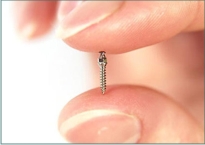 Heratsi Branch
Heratsi Branch
 Heratsi Branch
Heratsi Branch
 Heratsi Branch
Heratsi Branch
Orthodontic implants are small screws with a unique design, intended to create a temporary skeletal orthodontic support.
This is an innovative technology that has changed the vector of orthodontic work.
Orthodontic implants are made from medical-grade alloys. They serve as a stable anchor during orthodontic treatment.
- Reduction of treatment duration
- Replacement for complex surgical interventions
- Allow avoidance of external facial constructions (facial arches)
- Improvement of treatment quality
- Absence of discomfort for the patient
- Installation takes only a few minutes
The dentist examines X-ray images, then applies anesthesia and places the orthodontic implant directly into the bone, in a pre-selected area, without making any incisions on the mucous membrane.
During the consultation, the dentist will help you choose the orthodontic treatment method that best suits your specific clinical case.

